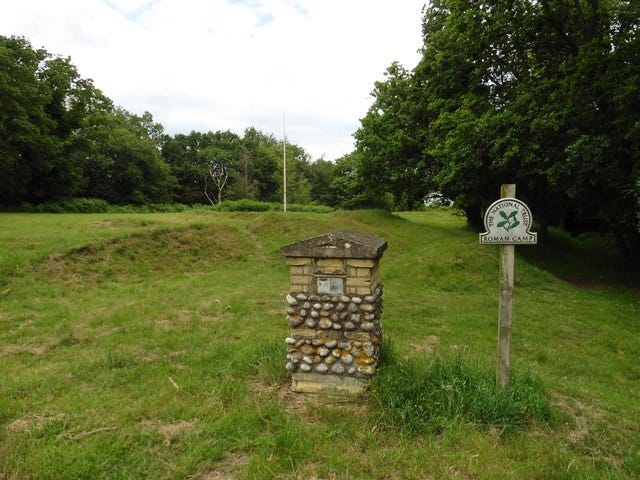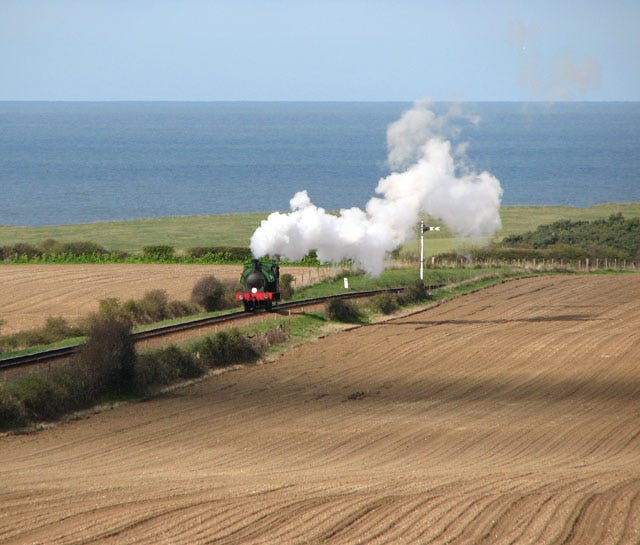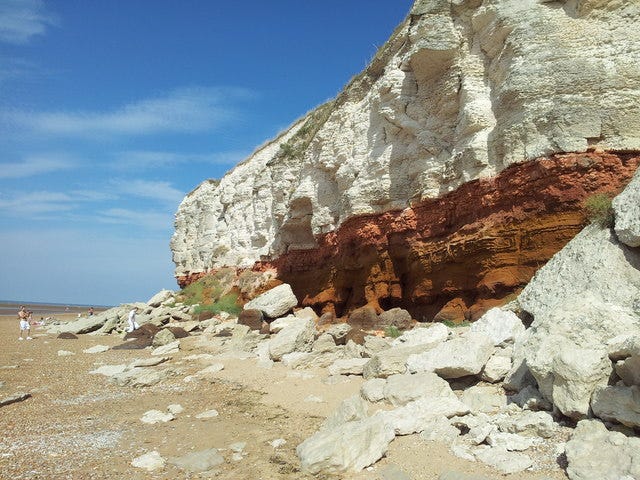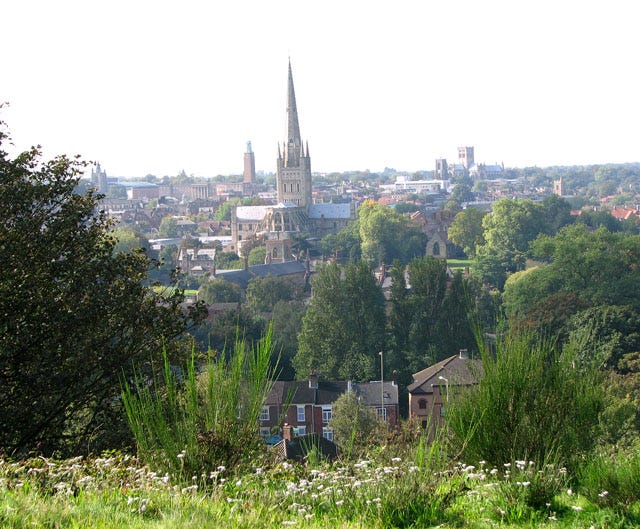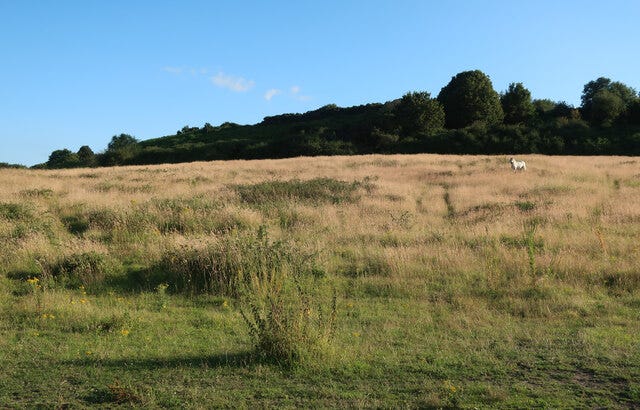Norfolk. Not So Flat.
The summit of Beacon Hill, the highest point in Norfolk (Roger Cornfoot/geograph)
“Very flat, Norfolk”.
That over-used and cutting phrase from Amanda, one of the character’s in Noel Coward’s comedy Private Lives.
He has a lot to answer for.
Norfolk is not, of course, a county of rolling hills and dale, of sweeping undulating vista and jagged peaks. But neither is it a featureless and unrelenting plain wholly devoid of occasional and unexpected highs and heights.
So Mr Coward, if you were implying that we in Norfolk don’t have any views to call our own, any hills, vistas and handsome outlooks, you really should have known better.
The highest point in Norfolk is Beacon Hill which is located a little under a mile south of the village of West Runton on the North Norfolk coast. It’s summit is 338 feet (103 metres) above sea level, a feature of the Cromer Ridge, an area of old glacial moraines that will be, no doubt, familiar to many a student of geography and geology (self included) who has partaken of a chilly morning there, shaking hands hardly able to cope with writing notes on rain soaked paper.
It may *only* be 338 feet high but, on a cold winters day when the lazy wind is cutting straight across and through you, direct and unopposed from the Arctic, you could just as easily be standing on any equally unexposed summit in the Himalayas.
Another lofted position can be found and walked at Muckleburgh Hill. Here you can take any one of a network of wooded footpaths which lead to the summit, one which affords some particularly fine views of the coast and surrounding area. Perfect for picnics-and a grand view of the Muckleburgh military collection on the fields below.
Looking down onto Weybourne from Muckleburgh Hill (David Martin/geograph)
You may, of course, prefer to take in your views from a sitting, rather than walking or even a standing position. If that is the case and you require further evidence to prove Coward wrong, then a trip on the North Norfolk Railway, the Poppy Line is for you.
Take a steam train from Holt and head off towards Sheringham, taking particular note of the rolling view down past the golf course and down towards the sea as you reach your destination, one of the loveliest in the county.
Norfolk’s Poppy Line. Well worth a visit. (Evelyn Simak/geograph)
One especially evocative if witnessed from the carriage of an always animated steam train, no matter whether you be 9 or 99.
It’s a ride that might have given ‘Amanda’ cause to reflect upon her ill chosen words.
More views can be taken in from the top of some of the cliffs that stand out on our coast. Cliff top scenes and dramatic drops are not the exclusive preserve of Cornwall and the mighty Atlantic Ocean. Our cliffs are, admittedly, modest in both length and height but that doesn’t stop them being any less eye catching. What about the famous multi coloured cliffs at Hunstanton for example, west facing and up to 60 feet (19 metres) high in places; they extend NNE from the promenade at Hunstanton to St Edmunds point, a short but striking view and walk beloved to both photographers and eager fossil hunters of all ages.
Hunstanton’s famous cliffs will bring out the geologist in you (Helen Steed/geograph)
Cliff spotters can be rewarded again if they travel the coast eastwards along the A149 until they reach West Runton, another Mecca for fossil hunters, the cliffs her sloping more gently towards the beach but no less dangerous and, sadly, fragile and susceptible to erosion.
So visit with care, with both yourself and your environment in mind.
Rich with fossils. The cliffs at West Runton (Hugh Venables/geograph)
A well known view to many is the one that can be seen and admired as you crest the top of the road of the B1153 as it nears the end of its 22 mile journey southwards from Narborough.
Heading out and away via Gayton and Docking, the road comes to a reluctant end in Brancaster, the scene as you approach the village a timeless one and a reminder of home as the travellers eye takes in the tower of St Mary’s Church; the fields that precede it and the salt marsh, creeks, beach and, finally, North Sea beyond.
You may not be very much higher than 60 feet above sea level here, yet it feels so much higher and grander, a wonderful canvas of Norfolk that is as majestic a scene as you will find anywhere in England.
Mousehold Heath, situated in north east Norwich offers some wonderful views of the City with the Cathedral as its timeless centre piece from Britannia Road. It’s an area of heathland and woodland which has been designated as a local nature reserve, one that is mostly covered by broad-leaf semi natural woodland with the areas of heath that surround it actively managed. St James’ Hill which lies adjacent to the old Britannia Barracks building is another great location for views across the City, as well as, in the winter, when snow abounds, a popular destination for sledges and other improvised winter sports.
Looking down onto Norwich from the top of St James Hill at Mousehold Heath (Evelyn Simak/geograph)
Back in the 1970’s, many of the steep slopes in and around the heath were utilised by then Norwich City Manager Ron Saunders for the purposes of training his first team squad. Yet he didn’t merely order them to run up them, they were expected to either do so whilst carrying a teammate on their back or by ‘bunny hopping’ their way to the grassy summit which, after every hop, must have seemed further and further away.
The Canaries of the day would have spent as much time at the top drinking in the air as they would have the views.
A final destination on this tour of some of the loftier views of Norfolk returns us to the coast and the heath at Salthouse. It is also part of the Cromer Ridge of glacial moraines, and an important wildlife site where, in early Summer, you can be lucky enough to while away a warm evening to the soundtrack of nightingales and nightjars. It’s also historically significant as it contains a large cluster of Bronze Age burial mounds, a tomb with a view for the well heeled chieftains of the day.
Hill country. Almost. The upper reaches of Salthouse Heath (Hugh Venables/geograph)
“Very flat, Norfolk”?
Not at all.
It is, and forever will be, a county of surprises. Majestic beaches and mighty skies are amongst its heights. But there are literal as well as metaphorical heights about Norfolk as well if you know where to look.
Which, quite evidently, was not something Noel Coward had ever done.




